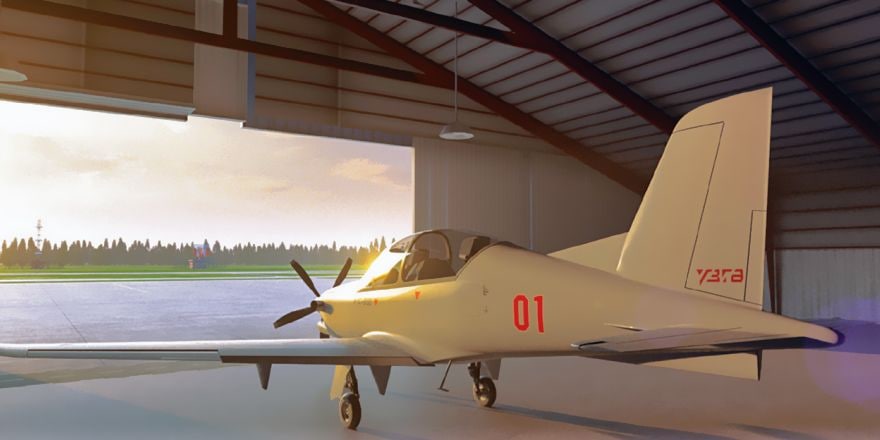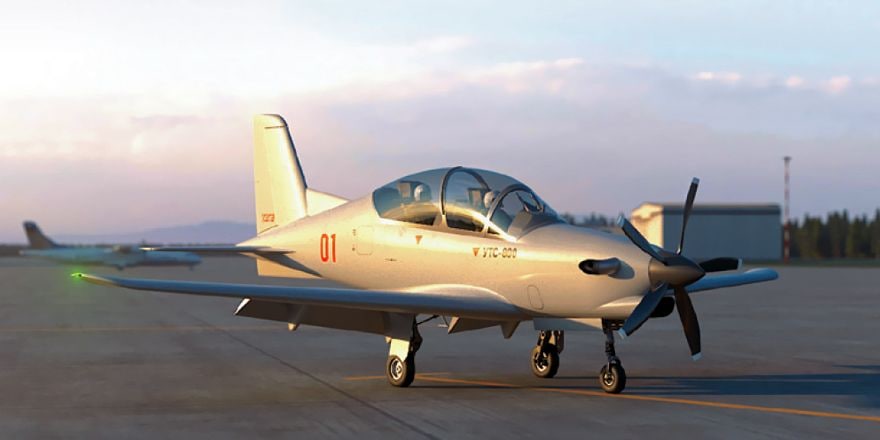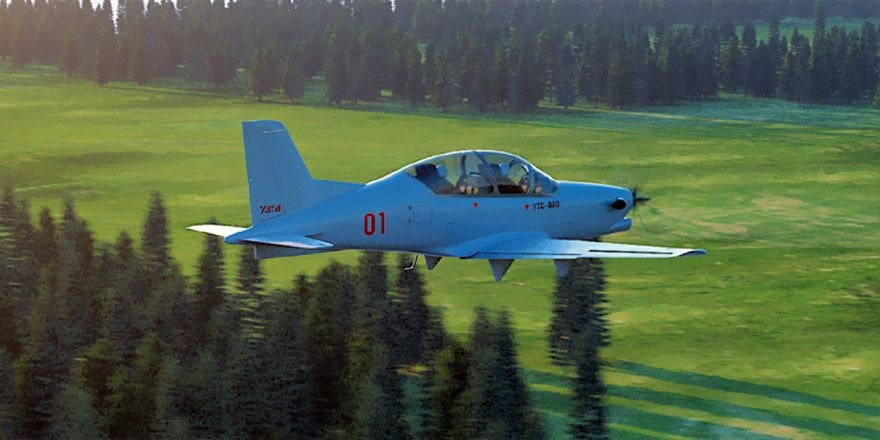UTS-800 – training complex for initial training of pilots. A traditional flight crew training course consists of an initial flight training program, a core or basic program, and a refresher program. One way to reduce costs is to switch from a three-to two-stage training model, in which the initial and main training is performed on the same type of aircraft, preferably a turboprop.
A training aircraft capable of solving such tasks is, for example, the Pilatus PC-9, developed by Pilatus Aircraft. The machine is widely used all over the world. Based on the PC-9, many modifications were built, including the T-6 Texan II training aircraft, which is the main TCB of initial and basic training in the United States. The average cost per flight hour of this type of aircraft is several times less than that of jet aircraft, and pilot training is much cheaper.
In Russia, the Yak-152, equipped with a 500-horsepower RED A03 V12 piston diesel engine of the German company RED Aircraft GmbH, is currently being tested. The peculiarity of this aircraft is that it is part of the training complex, which also includes the Yak-130 aircraft, a procedural simulator, training computer classes and a system of objective control tools. The complex is designed to solve the problems of initial training and professional selection of pilots at an early stage of training.
However, the launch of full-fledged mass production and the start of real operation of the Yak-152 are still delayed. At the same time, the aircraft is a constant participant in the International Aerospace Showrooms in Zhukovsky. The machine is not only shown as part of the static exposition of the Irkut Corporation, but also participates in the flight program of the air show. The history of the Yak-152 began in the early noughties, when the president of the OKB im. Yakovlev Oleg Demchenko decided to re-designate the Yak-54M training aircraft being created in the Yak-152.
The plane made its first flight on September 29, 2016, but its state tests have not yet been completed, and for five years there has been no certainty about the future of the Yak-152. The Ministry of Defense has not yet signed any contracts for the supply of this type of training aircraft to flight schools.
In July 2021, at one of the conference calls at the Russian Defense Ministry, the head of the Department, Sergei Shoigu, said that in order to update the fleet of training aircraft for initial training of combat aviation pilots, comprehensive tests of two promising models-the Yak-152 and UTS-800-will be conducted on a competitive basis.
There is little information about the project being developed by the Ural Civil Aviation Plant. It is known that the first flight copy of the UTS-800 will be assembled in December 2021 at UZGA, i.e., the comparison of the two vehicles can be carried out by the Ministry of Defense no earlier than the second half of 2022 — the Ural machine must first take to the sky and pass at least a program of factory finishing tests. At the same time, it should be borne in mind that the vehicles are fundamentally different in their power plant: the Yak-152 is equipped with an imported piston engine, while the UTS-800 is equipped with a VK-800PS turboprop produced by UEC-Klimov. During the construction of the aircraft, it is planned to use domestic technologies and materials. The main consumer of the UTS-800 will be flight schools of the Aerospace Forces.
About the features of the new aircraft and its production program in Russia interview Dmitry Tinyakov, Chief designer of the UTS-800, told Krylia Rodiny magazine
According to him, the aircraft is being developed in accordance with the current aviation regulations and existing technical requirements received from the operators. UTS-800 allows you to teach piloting techniques for simple and complex aerobatics in the altitude range from 1000 to 8000 m. The aircraft will be able to be based on artificial runways and unpaved runways.
"The UTS-800 has two options for refueling: for performing aerobatics and multi-purpose. By varying the amount of fuel refueled, you can get either an aerobatic plane for training aerobatics, or a significant flight duration, for example, flights on routes or patrols" – Dmitry Tinyakov said.
The aircraft's powerplant consists of one VK-800SP turboprop engine and a four-bladed AV-410P propeller. Power on the shaft in take-off mode is 806 hp. The power plant compartment is equipped with a fire extinguishing system, in addition, the fire alarm system allows you to get timely information about a fire in other compartments of the aircraft.
When designing the UTS-800, the main priorities that determine the development requirements were adopted: low cost of flight hours, reliability, active and passive safety, operational manufacturability, and training efficiency. The development of the machine is carried out with the maximum use of mass-produced domestic components with proven high reliability indicators, resources and service life.
The UTS-800 has a direct-acting mechanical control system. The necessary redundancy of all the main systems is provided: fuel, power supply, flight and navigation equipment, etc. The aerodynamic layout of the aircraft and wing profiling were chosen in order to ensure predictable reactions of the UTS-800 to gross piloting errors. When approaching critical angles of attack, a warning shake is provided. Special attention is paid to the behavior of the aircraft in a tailspin, ensuring safe entry and exit from the tailspin when performing training flights.
The chief designer of the aircraft noted that the flight characteristics of the UTS-800, including the landing speed, were chosen in order to ensure the formation of the necessary piloting skills and flight safety, especially during takeoff and landing. The aircraft is equipped with a hydraulically operated brake flap, which is released automatically when the maximum speed is reached.
The front landing gear is equipped with a steerable wheel, which simplifies taxiing and makes maneuvering around the airfield simple and safe. The separate braking of the wheels of the main chassis supports implemented in the design of the braking system is also aimed at solving this problem.
The crew is provided with the most comfortable conditions – a good view from the cockpit, a modern air conditioning and ventilation system, an anti-overload suit, oxygen equipment for performing flights at high altitudes, and efficient lighting equipment. As part of ensuring the safety of the cadet and instructor, the aircraft is equipped with a bird-resistant canopy of the cockpit light and is equipped with a complex of emergency escape means that allows you to leave the car in the entire range of altitudes and speeds, including on the ground.
The airframe structure is mainly made of domestic polymer composite materials, which provide weight and economic efficiency, high technological efficiency, a large resource and service life of the structure. Such solutions allow you to safely make an emergency landing "on the belly", including on water, but at the same time, the landing gear of the aircraft is equipped with a fully independent backup exhaust system, which minimizes the occurrence of such situations.
The tandem cabin layout allows the cadet to work completely independently with the cabin equipment, while the control priority remains with the instructor, which gives him full control over the cadet's actions. In the course of training, the instructor can simulate the failure of an avionics system, teach piloting techniques in simple and difficult weather conditions, and teach simple and complex aerobatics, including corkscrew flights.
"Within the framework of the UTS-800 project, UZGA is developing a comprehensive solution that provides training of flight and technical personnel in the sky and on the ground, as well as efficient operation and maintenance of the aircraft" – says Dmitry Tinyakov. "The UTS-800 training complex provides for the creation of not only the aircraft itself, but also technical training facilities as part of a simulator and a training class for flight and technical personnel, ground handling facilities and objective control facilities" – he said.
The complex provides training in piloting techniques in full, at any time of the day, in simple and difficult weather conditions, singly and as part of a group. State-of-the-art classroom software will allow you to study the design and operation features of the aircraft, piloting techniques in a simple and accessible form, and analyze training flights based on data obtained from objective control tools.
UTS-800 can be used in state flight training institutions, DOSAAF flying clubs, as well as in other training centers for timely selection at the initial and basic training stages of future professional pilots with savings of tens of millions of rubles for advanced flight training of each of them.
Source:
https://aviation21.ru/uts-800-uchebno-trenirovochnyj-kompleks-pervonachalnoj-podgotovki-lyotchikov/?_utl_t=tm











 Rodion_Romanovic
Rodion_Romanovic